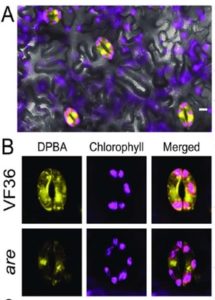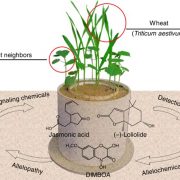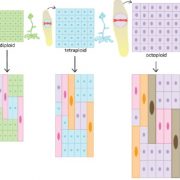ABA-induced reactive oxygen species are modulated by flavonols to control stomata aperture
 Much of our knowledge concerning ABA-induced stomatal closure comes from genetic models such as Arabidopsis and Vicia faba. Watkins et al. explore the mechanism of ROS production in this abiotic stress pathway in an important agricultural crop: tomatoes (Solanum lycopersicum). Specifically, they are interested in the role of flavonoids in guard cell dynamics of S. lycopersicum. Through a combination of genetic analysis utilizing two mutants displaying elevated or depleted flavonol levels, in addition to hormone treatment assays, it was determined that flavonoids act as antioxidizing agents and flavonoids are upregulated in the presence of ethylene. Flavonols counteracted ABA action by decreasing ROS accumulation. As ROS is required for ABA-induced stomatal closure, enhanced flavonol synthesis inhibited ABA-induced stomatal closure and was also shown to enhance stomatal opening. The inverse relationship was also seen in that less flavonol synthesis results in greater ROS accumulation and enhanced stomatal closure. Agricultural crop production is becoming increasingly important as Earth’s surface temperatures continue to rise and food availability becomes threatened. (Summary by Alecia Biel) Plant Phys. 10.1104/pp.17.01010.
Much of our knowledge concerning ABA-induced stomatal closure comes from genetic models such as Arabidopsis and Vicia faba. Watkins et al. explore the mechanism of ROS production in this abiotic stress pathway in an important agricultural crop: tomatoes (Solanum lycopersicum). Specifically, they are interested in the role of flavonoids in guard cell dynamics of S. lycopersicum. Through a combination of genetic analysis utilizing two mutants displaying elevated or depleted flavonol levels, in addition to hormone treatment assays, it was determined that flavonoids act as antioxidizing agents and flavonoids are upregulated in the presence of ethylene. Flavonols counteracted ABA action by decreasing ROS accumulation. As ROS is required for ABA-induced stomatal closure, enhanced flavonol synthesis inhibited ABA-induced stomatal closure and was also shown to enhance stomatal opening. The inverse relationship was also seen in that less flavonol synthesis results in greater ROS accumulation and enhanced stomatal closure. Agricultural crop production is becoming increasingly important as Earth’s surface temperatures continue to rise and food availability becomes threatened. (Summary by Alecia Biel) Plant Phys. 10.1104/pp.17.01010.









